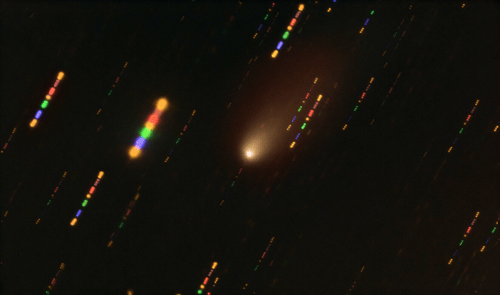| Mar 30, 2021 |
Interstellar comet is like nothing we've seen before
|
|
(Nanowerk News) Interstellar comet 2I/Borisov is more pristine than any other comet observed in the Solar System, reports a study in Nature Communications ("Unusual polarimetric properties for interstellar comet 2I/Borisov") this week.
|
|
The characteristics of the dust surrounding 2I/Borisov are shown to differ from those found in Solar System comets in a separate paper published in Nature Astronomy ("Compact pebbles and the evolution of volatiles in the interstellar comet 2I/Borisov"). The characteristics reported in these two papers support an interstellar origin for 2I/Borisov.
|
 |
| This image was taken with the FORS2 instrument on ESO’s Very Large Telescope in late 2019, when comet 2I/Borisov passed near the Sun. (Image:ESO/O. Hainaut)
|
|
Only two interstellar objects have been observed within our Solar System to date. The first, 1I/’Oumuamua has asteroid characteristics; the second, 2I/Borisov, shows evidence of cometary activity. Previous spectral observations of interstellar comet 2I/Borisov revealed spectral properties similar to those of Solar System comets, but characteristics of the dust particles that surround the nucleus have been unknown.
|
|
In the first paper, Stefano Bagnulo and colleagues measured the polarization of light scattered by the coma dust grains of interstellar comet 2I/Borisov to derive its physical characteristics. They find that the polarization of comet 2I/Borisov is higher than that measured for typical comets within our Solar System.
|
|
The only object with similar polarimetric properties is comet C/1995 O1 (Hale-Bopp). However, unlike Hale-Bopp and many other comets, the polarized light from the coma of interstellar comet 2I/Borisov is uniform, which suggests that it is a more pristine object than typical comets.
|
|
This observation indicates that comet 2I/Borisov may have never passed close to the Sun or any other star. 2I/Borisov may represent the first truly pristine comet observed, the authors conclude.
|
|
In the second paper, Bin Yang and colleagues report that the dust in the dust coma of interstellar object 2I/Borisov consists of compact “pebbles” (exceeding ~1 mm radius), differing from the loose aggregates typically found in Solar System comets. This compact dust is thought to be a result of impacts in the comet’s home system, and suggests that 2I/Borisov formed in a collapsing pebble cloud.
|

